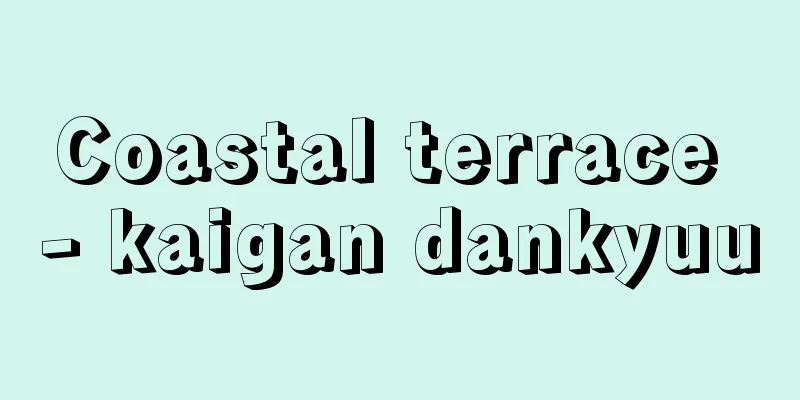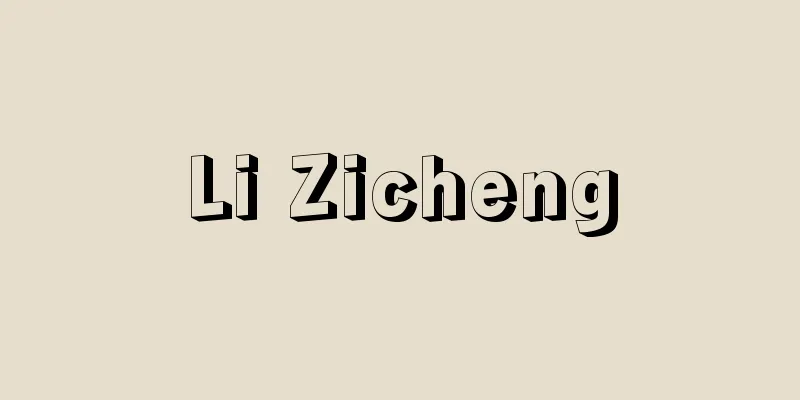Coastal terrace - kaigan dankyuu

|
A stepped landform distributed along the coastline. The flat surface is called a terrace surface, and the cliff in front of it is called a terrace cliff. From the glacial period about 150,000 years ago to the last interglacial period about 120,000 to 130,000 years ago, sea levels rose, and the coast was eroded by waves, creating a shallow sea floor called a sea-cut platform. Then, throughout the last glacial period several tens of thousands of years ago, parts of that sea-cut platform emerged above sea level (lifted off the water) while being deformed by the action of waves, wind, and rivers, and further during the post-glacial period from 20,000 years ago, the ground continued to rise without being eroded by waves, creating a sea cliff in front of it. The characteristics of coastal terraces vary depending on the amount of sediment and gravel supplied to the coast from the land. In places where there is little sediment and gravel supplied from the land, eroded terrace surfaces with little sediment are formed on a sea-cut platform made of bedrock, such as the Miura Peninsula and Enoshima. The same is true for coastal terraces on coral islands such as Okinawa, Saipan, and Guam, where a sea-cut platform (called a reef slope) that slopes offshore due to wave erosion during periods of sea level rise develops, and flat coral reefs develop at sea level. Similar topographical changes occurred on the shores of relict lakes (lagoons) such as Lake Kasumigaura, which was left behind as an inlet created during the Jomon Sea Level Rise about 5,000 years ago, and the subsequent drop in sea level and continued uplift of the ground formed a lakeshore plain. In contrast, where thick deposits of sediment were deposited on inlets and marine platforms by the supply of sediment from land not only during marine transgression but also during marine regression, sedimentary terraces developed. On the other hand, in places where sediment created by wave erosion of existing plateaus and hills was deposited on the marine platform during marine transgression but was not supplied from land during marine regression, such as the Shimousa Plateau on the Boso Peninsula, the deposited sediment was relocated and redeposited, resulting in the emergence of water. As with the last glacial period from tens of thousands to 20,000 years ago, there were other global glacial periods 150,000, 250,000, and 350,000 years ago, during which sea levels dropped worldwide. During the subsequent interglacial periods, sea levels rose by about 100 meters over a period of tens of thousands of years, so it is believed that similar changes in topography to those seen during the last glacial period must have occurred previously. However, the older the terraces, the gentler the terrace cliffs are, and the terrace surfaces are often narrower due to erosion. The height of the coastal terrace surface varies depending on the rate of uplift of the land. In coasts where the rate of uplift is particularly high, such as the coast of the outer Boso, the sea-cut platform created by wave erosion during the Jomon transgression about 5,000 years ago and the coastal lowlands or benches (wave-cut shelves) that formed on the coast have risen off the water to form high terrace surfaces (called Holocene terraces) with an elevation of over 20 meters. The former sea level at that time was only about 2 meters higher than today worldwide, so the land has risen by about 20 meters in the last 5,000 years. Similarly, the former sea level during the last interglacial period 120,000 to 130,000 years ago was only about 5 meters higher than today worldwide, but the marine terrace surface at that time (a name that focuses on its origin) called the Shimosueyoshi surface was about 40 to 100 meters high around the Kanto Plain, which shows that the edge of the Kanto Plain rose by several tens of meters in about 100,000 years. It is believed that the reason for land uplift is determined by the movement of large plates, but it is more likely that the more intense the erosion caused by rivers and waves, the lighter the land becomes, and the more the land rises in a way that maintains crustal equilibrium (isostasy). This may be why coastal terraces develop on the coasts of stable continents around the world. [Hiroshi Ikeda] "Sohei Kaizuka, "Developmental Geomorphology" (1998, University of Tokyo Press)" [References] | | | | | | |Marine | |Marine |Lake | | | reef| |Shimousa | | | | | | | |Near Cape Shiretoko, the tip of the Shiretoko Peninsula, which separates the Sea of Okhotsk from the Nemuro Strait, at the eastern end of Hokkaido. The two-tiered coastal terrace is clearly visible. The northern half of the peninsula is designated as Shiretoko National Park. Kunashiri Island can be seen on the horizon. Part of the World Heritage Site "Shiretoko" (registered in 2005) Shari Town, Shari District, Hokkaido and Rausu Town, Menashi District, Hokkaido © Shiretoko Shari Town Tourism Association "> Cape Shiretoko Source: Shogakukan Encyclopedia Nipponica About Encyclopedia Nipponica Information | Legend |
|
海岸線に沿って分布する階段状地形。平坦(へいたん)面を段丘面、その前面の崖(がけ)を段丘崖(がい)という。今から15万年ほど前の氷期以降、12万~13万年ほど前の最終間氷期(かんぴょうき)にかけて海面上昇が生じ、海岸が波による侵食(波食)を受けて海食台といわれる浅海底が生じた。その後数万年前以降の最終氷期を通じて、その海食台が部分的には波や風や川の働きを受けて変形しながら海面上に出て(離水して)、さらに2万年前以降の後氷期の海面上昇期を通して、地盤が波食されずに隆起し続けているために、前面に海食崖が生じたものである。 海岸段丘面の性状は陸地からどれほどの土砂礫(れき)が海岸に供給されるかによって異なる。陸地から土砂礫があまり供給されなかった所では、三浦半島や江の島のように、岩盤からなる海食台上に土砂があまりない侵食性の段丘面が生じる。沖縄やサイパン島、グアム島などのようなサンゴ島の海岸段丘も同様で、海面上昇期に波食によって沖に傾斜した海食台(礁斜面とよばれる)が発達し、海面の高さには平坦なサンゴ礁が発達する。5000年ほど前の縄文海進期に生じた入り江が埋め残された霞ヶ浦(かすみがうら)のような海跡湖(潟湖(せきこ)、ラグーン)の湖岸でも同様な地形変化が生じ、その後の海面低下および継続する地盤の隆起によって湖岸平野ができた。 これとは対照的に、海進時のみではなく海退期にも陸地から土砂礫が供給されて入り江や海食台上に土砂礫が厚く堆積(たいせき)した所では、堆積性の段丘面が発達した。一方、既存の台地、丘陵地が波食されて生じた土砂が、海進期には海食台上に堆積したものの海退期には陸地から土砂が供給されなかった所では、たとえば房総半島の下総台地などのように、堆積していた土砂礫が再移動、再堆積しつつ離水した。 なお、数万年前から2万年ほど前までの最終氷期と同様に、15万年、25万年、35万年前にも世界的な氷期があり、海面は世界的に低下した。その後の間氷期に数万年間で100メートルほどの海面上昇が生じたため、最終氷期と同様な地形変化が以前にも生じていたに違いないと考えられている。しかし、昔の段丘ほど段丘崖はなだらかで、段丘面も侵食されて狭くなっていることが多い。 海岸段丘面の高度は土地の隆起速度によって異なる。隆起速度がとくに大きな海岸では、外房の海岸のように、5000年ほど前の縄文海進期の波食によって生じた海食台と海岸に生じた海岸低地あるいはベンチ(波食棚(はしょくだな))とが離水して、標高20メートルを越える高い段丘面(完新世段丘という)になっている。当時の旧海面高度は世界的に現在より2メートルほど高かっただけなので、土地は最近の5000年間で20メートルほども隆起したことになる。同様に、今から12万~13万年前の最終間氷期の旧海面高度は世界的に現在より5メートルほど高かっただけなのに、下末吉面とよばれている当時の海成段丘(成因に着目した呼称)面は、関東平野周辺では40~100メートルほどの高さがあることから、10万年間ほどの間に関東平野の縁辺部は数十メートルも隆起したことがわかる。 土地が隆起する理由は大きなプレートの運動に規定されていると考えられているが、川や波によって激しく侵食されるほどに陸地は軽くなり、地殻均衡(アイソスタシー)が成り立つように隆起している可能性が高い。世界の安定大陸の海岸にも海岸段丘面が発達するのはこのためかもしれない。 [池田 宏] 『貝塚爽平著『発達史地形学』(1998・東京大学出版会)』 [参照項目] | | | | | | | | | | | | | | | | | | | | | | |北海道東端、オホーツク海と根室海峡とを分ける知床半島先端の知床岬付近。高低2段からなる海岸段丘がよくわかる。半島北半部は知床国立公園に指定されている。水平線上に見えるのは国後島。世界自然遺産「知床」の一部(2005年登録) 北海道斜里郡斜里町・目梨郡羅臼町©知床斜里町観光協会"> 知床岬 出典 小学館 日本大百科全書(ニッポニカ)日本大百科全書(ニッポニカ)について 情報 | 凡例 |
<<: Coastal plain - Kaiganheiya
>>: Coastline - Kaigansen (English spelling) coastline
Recommend
Yukihira pot - Yukihira pot
A thick ceramic pot, a type of earthenware pot. I...
Levallois Culture - Levallois Culture
This stone tool culture was named after the Levall...
Douc monkey - douc monkey (English spelling)
An Old World monkey of the Cercopithecidae family ...
Trauma
It refers to an injury caused to a part of the bo...
Cloud (■1) - Ungo
…It is also called the Ten-faced Luo or the Nine-...
Gallo‐Roman period
It refers to the period of Roman rule over Gaul fr...
Table Reef
...The planar and cross-sectional shapes of coral...
Bhoja I (English spelling)
…During this period, they occupied the largest po...
Sinzheimer
1875‐1945 German labor law scholar. A social democ...
Andronicus, L. (English spelling) AndronicusL
...In the following, we will look back historical...
eyebrows
The eyebrows are the group of hairs that grow den...
Juan Dias de Solis (English spelling) JuanDiasdeSolis
…a river that flows between Uruguay and Argentina...
Cosmic magnetic field - Uchuujiba
A general term for the magnetic field that permeat...
Minase Family - Minaseke
They are descendants of Michitaka, the son of Kane...
Charge transfer - Denkaido
The phenomenon in which electrons move from one at...









